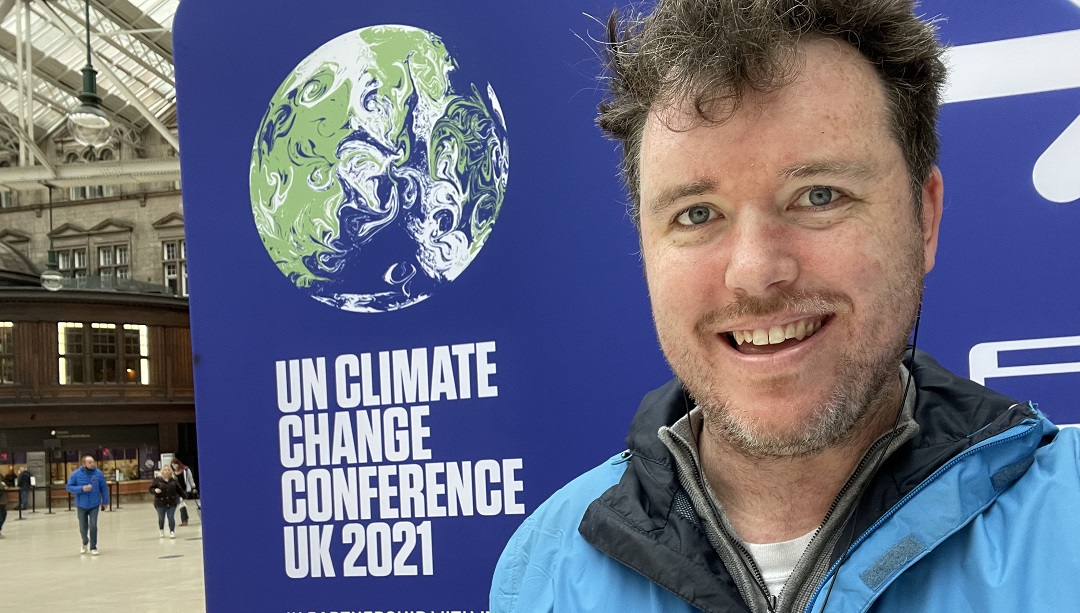By Kevin Andrew, Gustavson post-doctoral research fellow. Photo submitted.
I first recall learning about the United Nations in my high school ‘World Issues’ class. I had a passionate teacher named Mr. Smith who strongly believed in the capacity of the global community to work together to solve difficult problems. This class inspired my later choice to pursue a PhD in economics and then to pivot my research focus to the economic and financial risks related to climate change.
I have always been fascinated with difficult problems and climate change is perhaps the most difficult problem facing humanity. In economics jargon, it is the mother of all externalities. It is only fitting that the 2021 United Nations Climate Change Conference, or COP26, represented humanity’s last best chance to avert the worst consequences of climate change. I was humbled to be able to attend, and was part of a group funded by Pacific Institute for Climate Solutions (PICS).
COP26 is short for the Conference of the Parties to the United Nations Framework Convention on Climate Change (just one of the many acronyms associated with the conference). It was a two-week conference held in Glasgow, Scotland, Oct. 31-Nov. 12, 2021. World leaders, activists, academics, NGOs and corporations attended. COP26 involved the final negotiations of the Paris Climate Agreement, country pavilions, side events, educational experiences and opportunities to network. There were just under 40,000 registered participants. The conference centre was teeming with people from all over the world while the streets were full of protesters. The event truly was a spectacle.
I was overcome with emotion when I first entered the conference due to the gravity of the event. This was a first for me. I followed developments related to public and private finance most carefully, but I also had the opportunity to see Al Gore speak about physical climate damages, to learn about developments in low-emissions agriculture and to see Canada’s transport minister speak about our plans to electrify road transport. Oh yes, and I even caught a brief glimpse of Barack Obama.
Private and public finance were prominent elements of the COP26 program. During the first two days of the conference the mood was quite tense as developed countries had failed to meet the $100 billion USD annual commitment of providing climate finance to developing countries. This failure was repeatedly mentioned throughout the conference.
The Glasgow Financial Alliance for Net-Zero (GFANZ) was announced on day three of the conference. The alliance was spearheaded by a Canadian, Mark Carney, who is the UN Special Envoy for Climate Action and Finance. GFANZ membership includes more than 450 financial firms from 45 countries. These include banks, insurers, pension funds, asset managers and other finance industry players.
Another important announcement on climate finance day was the formation of a new accounting standards body called the International Sustainability Standards Board, or ISSB. This board will be responsible for developing a global minimum accounting standard for sustainability-related disclosures. Accounting standards, or the financial plumbing, are an underemphasized, but very important precursor to real change by the private sector. Having a global minimum standard will force companies to report their climate-related activities in a consistent way, allowing for comparability. This empowers investors to make decisions to decarbonize their portfolios or to engage high emitters to change their business practices. It may also be possible to link executive compensation to sustainability metrics.
My experience at COP26 taught me that there is a momentum to multi-lateral climate policy. While COP26 did not achieve the tangible emissions-reduction promises some would have liked, it also left the door to a world with 1.5C warming slightly open. In other words, it is still code red for humanity, but at least humanity can live to fight another round.
I also saw that there is a symbiotic relationship between government and non-government actors in developing solutions to climate change. Neither can solve the mother of all externalities alone. Government policy is reinforced by announcements from the private sector, such as GFANZ. Lastly, I would acknowledge that for many of the protestors, COP26 did not achieve nearly enough. Young people are rightly frustrated with compromise and moral victories. They want radical action now. I would like these passionate young people outside the venue to know that, personally, I heard them and took their message to heart.


